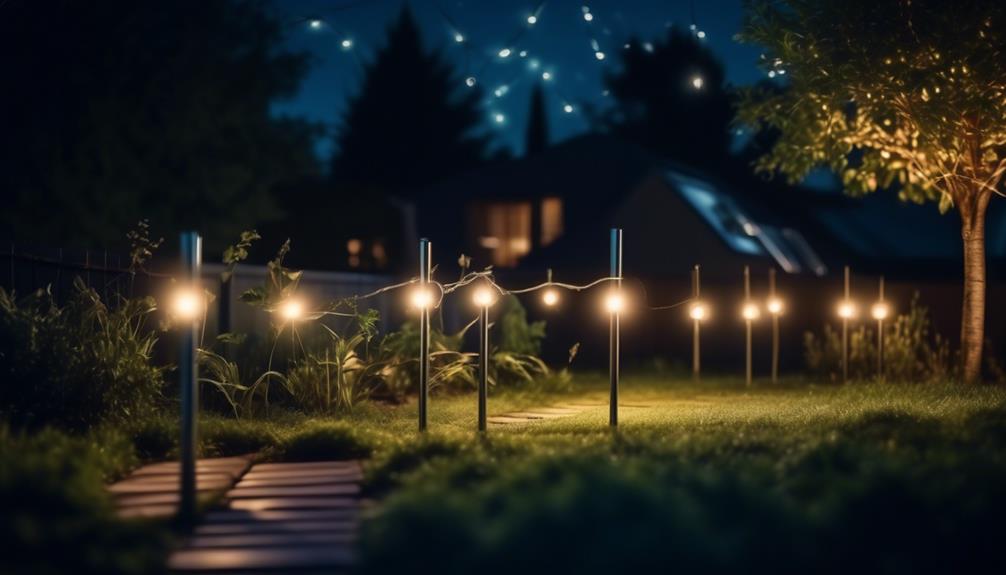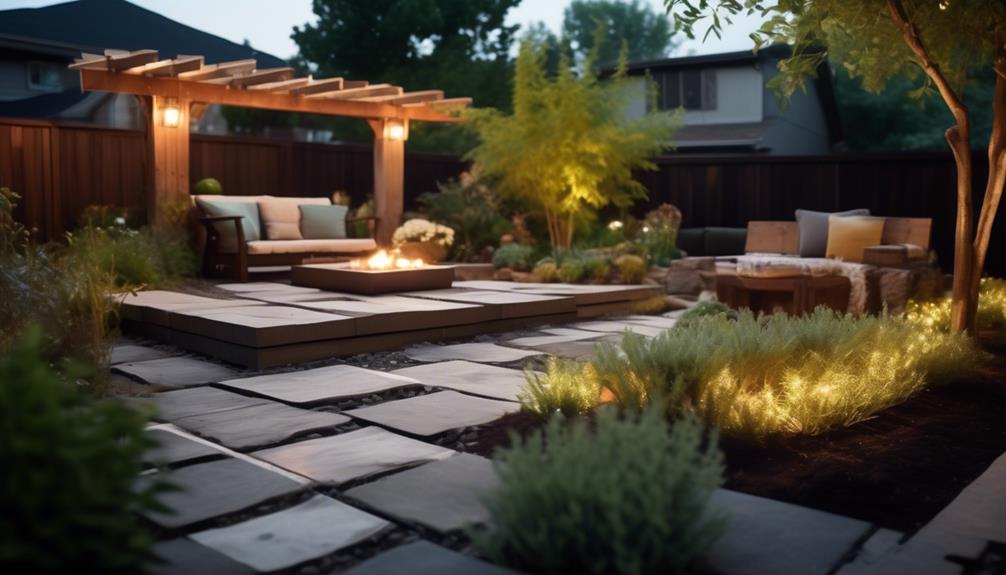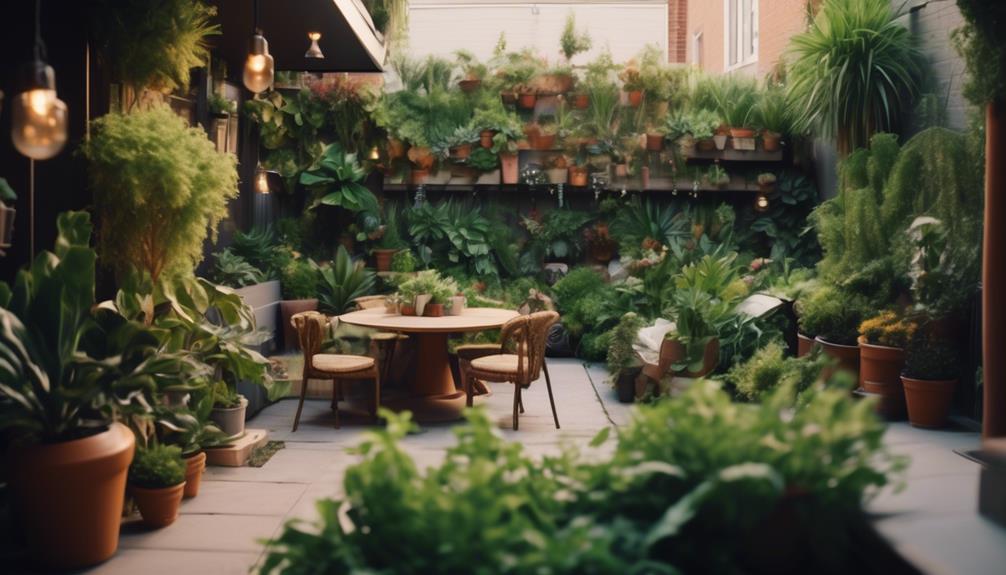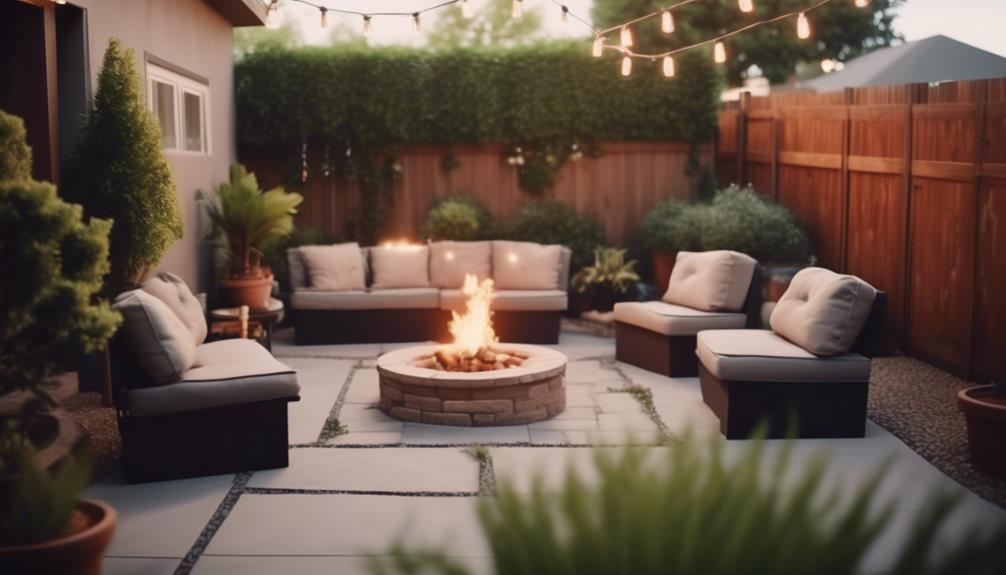As I was standing in my backyard, admiring the lush greenery and vibrant blooms, it struck me how much our outdoor spaces can be a metaphor for sustainability.
The choices we make in yard design and maintenance can have a significant impact on the environment, from conserving water to supporting local wildlife.
In my quest for a more eco-friendly landscape, I’ve discovered six essential tips that not only enhance the beauty of the yard but also promote sustainability.
From selecting native plants to embracing innovative irrigation systems, each step plays a crucial role in creating a harmonious and environmentally conscious outdoor haven.
Join me as we explore these practical and effective strategies for a greener yard, where every detail contributes to a sustainable landscape that benefits both nature and our well-being.
Key Takeaways
- Prioritize drought-resistant native species for optimal plant selection and water conservation.
- Implement composting and mulching techniques to enrich soil, reduce the need for chemical fertilizers, and divert organic waste from landfills.
- Use natural pest control methods such as biological controls and companion planting to maintain a balanced ecosystem.
- Choose renewable energy sources like solar-powered fixtures and energy-efficient LED lights for outdoor lighting to reduce energy consumption and lower utility bills.
Native Plant Selection
When selecting native plants for your yard, consider the specific environmental conditions of your region to ensure optimal growth and ecological benefits. It’s crucial to choose plants that are well-suited to the soil in your area. Soil enrichment is key to the success of native plants. Before planting, test your soil to determine its pH and nutrient levels. This will help you understand if your soil needs any enrichment, such as adding organic matter or specific nutrients to create the perfect environment for your chosen native plants.
Furthermore, drought resistance is another vital factor to consider when selecting native plants. With climate change leading to more frequent and severe droughts in many regions, choosing plants that can withstand long periods without water is essential. Look for native species that have naturally adapted to survive in your area’s climate conditions. These plants often have deep root systems or other mechanisms to store water, making them resilient during dry spells.
Water-Wise Irrigation Systems
To create an efficient and sustainable irrigation system, consider incorporating water-wise techniques that optimize water usage and minimize waste.
Drip irrigation is a great way to deliver water directly to the roots of plants, reducing evaporation and water runoff. This method also helps to prevent weed growth and disease by keeping foliage dry.
Rain barrels are another fantastic option for collecting rainwater, which can then be used for watering the garden, reducing the need for tap water.
Xeriscaping is a landscaping technique that utilizes drought-resistant plants to minimize water usage. By choosing plants that are well-suited to the local climate, you can significantly reduce the need for irrigation.
Additionally, greywater reuse, which involves recycling household water from sources like sinks and showers, can be used for irrigation purposes. This helps to conserve fresh water resources while providing a sustainable irrigation solution.
Implementing these water-wise irrigation systems not only reduces water consumption but also promotes a more eco-friendly and sustainable yard. By being mindful of water usage and incorporating these techniques, you can create a beautiful landscape while minimizing environmental impact.
- Affordable DIY Landscaping Tips for Small Yards
- Creative Small Yard Landscaping Ideas for Urban Homes
- 13 Stunning Modern Minimalist Yard Designs
- What Are Easy Low-Maintenance Yard Design Ideas?
Composting and Mulching Techniques
I’ve found that incorporating composting and mulching techniques into yard design can significantly benefit soil health.
Composting can enrich the soil with essential nutrients and improve its structure.
Mulching helps retain moisture and suppress weed growth.
Both techniques not only contribute to a healthier yard but also promote sustainability by reducing the need for chemical fertilizers and water.
Benefits of Composting
Composting and mulching techniques offer numerous benefits for eco-friendly yard design, including enriching the soil, reducing the need for chemical fertilizers, and retaining moisture. Composting benefits the environment by diverting organic waste from landfills, where it would release methane, a potent greenhouse gas. Additionally, it reduces the need for chemical fertilizers, which can leach into waterways and harm aquatic ecosystems. By enriching the soil with valuable nutrients, composting fosters healthy plant growth and increases the soil’s ability to retain moisture, thus reducing the need for irrigation. Moreover, composting methods contribute to organic waste management, promoting sustainable practices and reducing overall waste. The table below illustrates some of the key benefits of composting:
| Benefits of Composting | Environmental Impact | Organic Waste Management |
|---|---|---|
| Enriches soil | Reduces methane emissions | Diverts organic waste from landfills |
| Reduces need for chemical fertilizers | Minimizes water pollution | Promotes sustainable waste practices |
| Retains moisture | Supports healthy ecosystems | Reduces overall waste |
Mulching for Soil Health
Mulching for soil health plays an integral role in maintaining the enriched soil and moisture retention achieved through composting, contributing to the overall sustainability and vitality of an eco-friendly yard.
When mulching, it’s crucial to use organic matter such as leaves, grass clippings, or compost to enrich the soil. This organic matter decomposes over time, releasing valuable nutrients into the soil, promoting healthier plant growth.
Additionally, mulch acts as a protective barrier, reducing moisture evaporation from the soil and helping to suppress weed growth. To ensure optimal moisture retention, apply a 2-3 inch layer of mulch around trees, shrubs, and garden beds.
Eco-Friendly Pest Control Methods
Implementing natural predators, such as ladybugs and praying mantises, can be an effective eco-friendly pest control method in your yard. These beneficial insects feed on common garden pests like aphids, caterpillars, and mites, helping to maintain a balanced ecosystem. In addition to natural predators, biological controls like nematodes, which are microscopic roundworms that target specific pests, can be used to manage unwanted insects without harming other beneficial organisms. Another eco-friendly approach is companion planting, where certain plants are grown together to repel pests, attract beneficial insects, or enhance the growth of companion plants. For instance, planting marigolds alongside vegetables can deter nematodes, while basil can repel mosquitoes and flies when planted near outdoor seating areas. Moreover, DIY repellents using ingredients like garlic, neem oil, or soap can help control pests without resorting to harmful chemicals. Below is a table summarizing these eco-friendly pest control methods:
| Pest Control Method | Description |
|---|---|
| Natural Predators | Ladybugs, praying mantises |
| Biological Controls | Nematodes targeting specific pests |
| Companion Planting | Marigolds, basil, and other plants with pest-repelling properties |
Renewable Energy for Outdoor Lighting

When it comes to outdoor lighting, I always prioritize renewable energy options such as solar-powered fixtures and energy-efficient LED lights.
Not only do these options help reduce energy consumption and lower utility bills, but they also have a positive impact on the environment.
Solar-Powered Lighting Options
I recommend considering solar-powered lighting options for your outdoor space, as they provide an eco-friendly and renewable energy source for illuminating your yard.
Solar panels on these lights harness sunlight during the day and convert it into electricity, which is then stored in rechargeable batteries for use at night.
These lights are perfect for outdoor illumination, offering a soft and ambient glow that enhances the beauty of your landscape while also contributing to energy conservation.
When selecting solar-powered lighting, look for durable designs with efficient photovoltaic cells and long-lasting LED bulbs.
Position the solar panels in an area that receives ample sunlight to ensure optimal charging.
With a range of styles available, including path lights, string lights, and spotlights, you can easily find the perfect solar-powered lighting options to suit your yard’s aesthetic and functional needs.
Energy-Efficient LED Fixtures
Consider incorporating energy-efficient LED fixtures in your yard for a sustainable and cost-effective outdoor lighting solution.
LED fixtures are a great choice for cost-effective installation, as they consume significantly less energy than traditional lighting options. This not only reduces your electricity bills but also minimizes the environmental impact.
Additionally, LED fixtures have a much longer lifespan than conventional bulbs, resulting in long term savings on replacement and maintenance costs.
When it comes to outdoor lighting, durability is crucial, and LED fixtures excel in this aspect, making them a practical and sustainable choice for your yard.
Their energy efficiency, longevity, and low maintenance requirements make them an ideal option for environmentally conscious homeowners seeking a reliable and eco-friendly lighting solution.
Benefits of Renewable Energy
Incorporating renewable energy sources such as solar or wind power for outdoor lighting offers a sustainable and environmentally friendly way to illuminate your yard. By utilizing solar panels or wind turbines, you can harness the power of nature to light up your outdoor space without relying on traditional electricity. Not only does this approach reduce your carbon footprint, but it also provides a cost-effective and low-maintenance solution for outdoor lighting. Below, I’ve outlined the benefits of using solar panels and wind turbines for outdoor lighting:
| Benefits of Solar Panels | Benefits of Wind Turbines |
|---|---|
| Harnesses sunlight, sustainable | Uses wind energy, sustainable |
| Low maintenance, long lifespan | Low maintenance, long lifespan |
| Cost-effective, reduces electricity bills | Cost-effective, reduces electricity bills |
Using renewable energy sources for outdoor lighting not only contributes to a greener environment but also offers practical and economical advantages for your yard.
Sustainable Hardscaping Materials

When selecting sustainable hardscaping materials for your yard, it’s important to prioritize options that are durable, low-maintenance, and environmentally friendly. One excellent choice is using recycled materials for hardscaping projects.
These materials, such as recycled concrete or reclaimed wood, not only provide a unique and stylish look to your yard but also reduce the demand for new resources.
Additionally, permeable pavers are a great option for sustainable hardscaping. These pavers allow water to drain through the surface and infiltrate into the soil, reducing stormwater runoff and helping to recharge groundwater. They also prevent erosion and filter pollutants, contributing to a healthier environment.
When considering sustainable hardscaping materials, it’s essential to prioritize longevity and minimal environmental impact. By opting for recycled materials and permeable pavers, you can create a beautiful and eco-friendly landscape that aligns with your sustainable living goals.
These choices can significantly reduce the environmental footprint of your yard while still providing the functionality and aesthetic appeal you desire.
Frequently Asked Questions
Are There Any Local Resources or Organizations That Can Help With the Implementation of Eco-Friendly Yard Design?
There are several local resources and organizations that can help with eco-friendly landscaping, including community gardening groups, environmental nonprofits, and sustainability-focused businesses. Their expertise and support can make a big difference in creating a sustainable yard.
How Can I Incorporate Wildlife Habitats Into My Sustainable Landscape Design?
Incorporating wildlife friendly landscaping into my sustainable design involves native plantings, creating biodiverse habitats for conservation. I focus on providing shelter, water, and food sources to support local wildlife and promote a thriving ecosystem.
Are There Any Specific Considerations for Incorporating Eco-Friendly Yard Design in Urban Areas?
In urban areas, eco-friendly yard design must address unique challenges. Space limitations often require creative solutions, like vertical gardens and permeable pavement. Utilizing native plants and efficient irrigation systems can maximize sustainability in this environment.
What Are Some Creative Ways to Repurpose Materials in My Yard for a More Sustainable Landscape?
When looking to create a more sustainable landscape, I love incorporating upcycling projects into my yard. Repurposing materials like old pallets for planters and using sustainable landscaping materials like gravel and reclaimed wood can make a big impact.
How Can I Involve My Community in Promoting Eco-Friendly Yard Design and Sustainability Practices?
To involve my community in promoting eco-friendly yard design and sustainability practices, I’d organize outreach programs and workshops for environmental education. We can collaborate on sustainable initiatives, like community gardens and water conservation projects, fostering a collective commitment to our environment.
Conclusion
In conclusion, creating an eco-friendly yard doesn’t have to be difficult. By selecting native plants, using water-wise irrigation, composting and mulching, employing eco-friendly pest control methods, utilizing renewable energy for outdoor lighting, and choosing sustainable hardscaping materials, you can create a beautiful and sustainable landscape.
These tips are practical and easy to implement, allowing you to enjoy a beautiful yard while also reducing your environmental impact.
Make the choice to go green with your yard design today!

